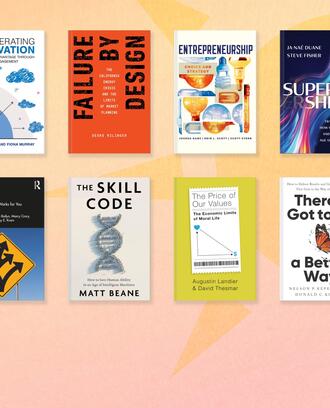Credit: Triff / Shutterstock
The COVID-19 pandemic upended life as we know it, putting many long-standing business assumptions to the test. Now as the world tries to envision a post-pandemic future, experts in innovation say place-based ecosystems are more relevant than ever.
Despite myriad challenges from lockdowns to interruptions of global supply chains, the idea that proximity helps inspire novel ideas and produce disruptive products has endured. In an innovation ecosystem, organizations engage with a diverse range of external players to accelerate their innovation cycles, a phenomenon that has led to geographic hotspots for innovation from Silicon Valley and New York, to Shenzhen, China and Cape Town, South Africa.
In these ecosystems, ideas move more seamlessly from inception to impact thanks to the coming together of five key stakeholder groups: universities, government, corporations, entrepreneurs, and risk capital.In fact, innovation ecosystems played a central role in developing COVID-19 vaccinations, according toco-director of the MIT Innovation Initiative. The Moderna team based in Cambridge, Massachusetts, started work on an mRNA vaccine in 2012, with patient risk capital seeded from nearby Boston (in addition to government funding), and a number of local universities heavily involved in the foundational mRNA ideas, she said.
“You can see that at least some of these key players were co-located in dense ecosystems like Cambridge. Likewise, BioNTech, which works with Pfizer, was co-located in Germany,” said Murray, associate dean for innovation and inclusion at MIT Sloan. “We can see how these innovation ecosystems have been really important to innovations that mattered to us during the pandemic.
“Although the streets of many traditional innovation hubs may still be rather quiet, the innovation ecosystem is going to hold, although I think it will hold in a slightly different way. We will see that smaller-scale ecosystems — supported by digital collaboration technologies — are going to thrive and be very vibrant,” said Murray, citing locales like Leeds, England and Belfast, Northern Ireland. “In fact, they may be more vibrant because people don’t want to go back into the gigantic ecosystems of the past.”
A roadmap for innovation ecosystems
In a recent webinar hosted by MIT Sloan Executive Education, Murray and senior lecturerdetailed how innovation ecosystems should evolve to address the following:
Hybrid models. Mirroring what’s happening with the return to the office, there will be fresh takes on the innovation ecosystem, with variations that pair in-person and geographically distributed teams, and leverage both digital and physical forms of engagement. There is also an emerging concept of an inter-ecosystem network whereby a successful ecosystem syncs up with other such ecosystems, and a realization that, while we need to go global with innovation, we also need to think local and extend the innovation ecosystem to the local heartland.“The flux and disruption from the pandemic give us a chance to do things differently,” Budden said.
While innovation-driven entrepreneurship will be more distributed, the world still won’t be entirely flat for innovation.
“It’s not going to be evenly spread across every square mile, but I think that there is now a shift away from some of the big cities,” Budden said. “There is an opportunity for other places to pick up some of the globally-mobile talent who can work in cities in the American heartland, up in north England, or in various parts of Latin America.”
An emphasis on diversity and inclusion. Diversity is a powerful driver of innovation and leads to significantly better outcomes. As in other areas of the business, organizations must focus on being consciously inclusive, here with innovation ecosystems where diversity of perspectives, backgrounds, and experiences can be brought to bear, Murray said. Not only should there be a focus on harnessing the best of global talent, but also on leveraging local talent that may have previously been shut out from participating in the innovation ecosystem due to lack of access, networks, or training.
Related Articles
In her role as MIT Sloan’s associate dean for innovation and inclusion, Murray is putting these ideas into practice, leading the creation of a new space on MIT’s campus — innovationHQ — where a more diverse group of innovators can be co-located. In a similar way, organizations should ramp up efforts to address inequalities through an emphasis on training, collaborative events like hackathons, and forums that promote community connection and engagement.
Changes also need to happen at the risk capital level to encourage the investor community to back people and resources that are not in their own backyard. The pandemic exposed venture capitalists to remote dealmaking online, making it hard to argue now that money can only be invested in startups within driving distance.
“We have to work out how to open our doors to these individuals and make sure we have innovation and entrepreneurship programs to connect and listen to the ideas that are coming from the community — not just go out there and tell people what to do.” Murray said. “You have to be willing to open up these social networks to people who are different from you and different from the people you’ve invested in before.”
Breaking big challenges into focused problems. One of the reasons COVID-19 vaccine development was such a success was because major global ecosystems were galvanized to solve a very focused set of problems. Compare that track record to another major disruption this last year — supply chain resilience, which was more difficult to synthesize into a discrete problem, and thus remains an ongoing challenge.
As nations rally innovation efforts to solve major challenges like climate change, global health inequality, and security and defense, Murray makes the case for breaking down big challenges into more focused, manageable problems.
“We need to have a series of clearly articulated missions and problems because I think human communities and these ecosystems tend to work better when they have more focus,” she said.
Leverage digital technology as an enabler. It’s highly likely that hybrid innovation ecosystems will develop where there aren’t all five stakeholders available as part of a local geographic area, Budden said. Leveraging technology to augment an ecosystem also opens up doors to smaller enterprises to participate in the process. Smart use of digital technologies can close those gaps and create a foundation for new forms of ecosystem and network engagement, particularly at critical moments in the innovation process.
“The challenge for corporate executives and ecosystem leaders is to figure out at what moments in the innovation process they need to be together in person — maybe for team building or hacking — before they can go off and do the coding or primary research separately,” Budden said.
Such strategic engagement of the ecosystem will give companies a competitive advantage in their efforts at corporate innovation, he said.
As organizations move ahead with the twists and turns of re-imagining ecosystems and the future of innovation, one path is consistently clear: the human dimension will remain central to the equation, which means companies will need to be creative and strategic about ecosystem engagement.
Said Murray: “Face-to-face interaction is going to remain at a premium, and that’s going to be a scarce resource that we’ll have to think about differently.”



